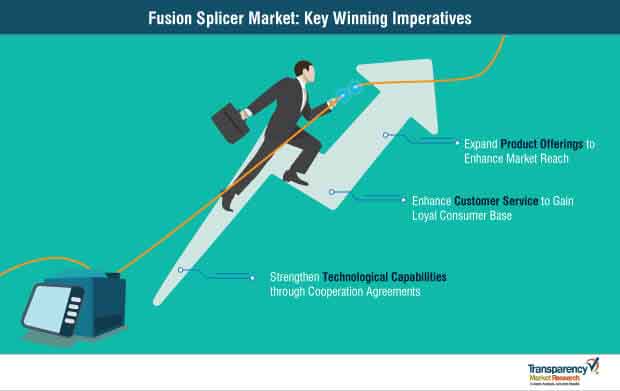
Fusion Splicer Market: Need for Enlarged Bandwidth to Create Avenues of Growth
In today’s day and age, our lives are highly dependent on ‘hyperconnectivity’, be it a person-to-person, person-to-machine, or machine to machine connection. With hyperconnectivity being the buzzword, there has been a surge in the adoption of cloud-based infrastructure, which essentially demands enlarged bandwidth of fiber optic cabling. Such strides towards data-intensive services have strengthened the roots of the fusion splicer market. To make a mark in the converging multibillion-dollar information industry, players in the telecommunication sector are beefing up their networks using fusion splicing techniques.
With the convergence of voice, video, and data networks, and high FTTH (fiber-to-the-home) deployments, there is an increasing amount of optical fiber being fusion spliced. Fusion-splicer is rapidly becoming the must-have tool for almost all industries, including, telecommunications, aerospace and defense, energy, medical, and others. The mounting demand for high-bandwidth network and optical fiber gaining center stage in almost every networked organization warrants the need for exhaustive research to understand the dynamics of the fusion splicer market. In its latest offering, Transparency Market Research (TMR) details out the trends and transitions in consumer behavior that will help stakeholders take well-informed business-related decisions.
Planning to lay down future strategy? Perfect your plan with our report brochure here https://www.transparencymarketresearch.com/sample/sample.php?flag=B&rep_id=34235


Evolutionary Timeline of the Fusion Splicer Market
There has been incessant progression in optical fiber network construction. With innovations spawning in the arena of fiber optics, ‘fusion splicing’ gradually became the new business adage, being one of the most economical and fastest methods for field termination. The industry is graduating its way to progress with upgrades in optical communication technology and advancements in gaming-on-demand, video on demand, and digital video recorder networks.
The telecommunications industry, in particular, is a major revenue contributor for the fusion splicer market, with nations focusing on expanding their fiber-optics communications. This industry accounted for ~ 55% of the market share in 2018, and is anticipated to rise at a CAGR of ~ 6% during the forecast period.
Furthermore, shifts in consumer preferences from mechanical splicing to fusion splicing have transcended the industry’s growth. However, the high costs associated with fusion splicing devices and the need for continuous power supply may drive consumers away. Although this is a long-standing challenge for the market, it opens new growth opportunities, especially for new market entrants, where they can proliferate the global market by launching competitively-priced products.
Compelling Trends Redefining the Market
Sensing the high demand for fusion splicers, numerous manufacturers are increasing their production capacities. However, to establish a strong foothold in the market, there is the need for players to launch products with advanced functions. Partakers are targeting specific consumer demands, such as the development of compact and lightweight fusion splicers for homes, and the development of wireless splicers to meet the need for continuous power supply. For instance, Fujikura Ltd., a Japanese company, recently announced the launch of the wireless smart splicer 41S, which is expected to provide exact core splice loss estimation.
Another overarching trend in the fusion splicer industry is the high adoption of core alignment splicers. This is mainly because they need to meet specific contract specifications for spice loss. Manufacturers are not only increasing the production of core alignment splicers but expanding the applications of core alignment splicers in the cable TV industry. This is mainly because this industry demands low splice loss of 0.05 decibel or even lower, which can only be achieved through core alignment splicers.
Looking for exclusive market insights from business experts? Request a Custom Report here https://www.transparencymarketresearch.com/sample/sample.php?flag=CR&rep_id=34235
Key Winning Imperatives
Sensing the high demand for fusion splicers across various industry verticals, players are laying high focus on increasing their product offerings of innovative products to enhance their market reach and sales revenues. This aspect of the market has greatly encouraged the decision of NanJing DVP O.E.TECH. CO., LTD. to expand its product offerings. Similarly, in September 2018, Sumitomo Electric Industries, Ltd. released the splicer T-57, which is an updated version of the prior splicer, T-55. The new product offers enhanced features such as better portability, less heating time, large battery capacity, and smart user interface, besides others.
Furthermore, gauging the rising consumer inclination towards innovative and technologically-advanced products, companies are striving to strengthen their technological capabilities. They are doing so through cooperation agreements with leading enterprises, research institutes, and companies. For instance, China Electronics Technology Group Corporation signed a strategic cooperation agreement with Southeast University for cooperation in scientific researches and technological innovation.
Competition Landscape to Remain Fragmented
The global fusion splicer market features a highly fragmented vendor landscape, with the presence of numerous established companies and the emergence of new players. In 2018, emerging players accounted for ~ 52% of the market share, whereas, prominent and leading players held ~ 22% and ~ 25% of the market share, respectively. Leading companies in the fusion splicer market include Sumitomo Electric Industries, China Electronics Technology Group Corporation, Furukawa Electric, and Fujikura Ltd.
Key players are relying on strategies such as deployment of robust product promotion strategies, new product launches, and better customer service to expand their global frontiers. In a bid to enhance customer service, SIGNAL FIRE TECHNOLOGY CO., LTD offers various services such as lifetime warranty and free parts, and free replacement of the fusion splicer, when the splicing count reaches 50,000. On the other hand, Ilsintech Co., Ltd.is focusing on sales promotions to enhance its sales revenue.
Apart from these strategies, companies are also focusing on acquiring quality assurance certificates to instill faith in customers and enhance the credibility of their products. For instance, Nanjing Jilong Optical Communication Co. LTD has obtained quality assurance certificates such as Great Wall Quality Assurance Center ISO9001 quality system certification, OHS18001 occupational health and safety, and ISO14001 environmental management system certification.
More Trending Reports by Transparency Market Research –
Contact
Transparency Market Research
90 Sate Street, Suite 700
Albany, NY 12207
Tel: +1-518-618-1030
USA – Canada Toll Free: 866-552-3453
Email: sales@transparencymarketresearch.com
Website: https://www.transparencymarketresearch.com/





